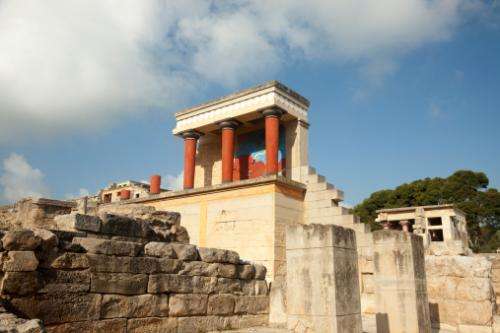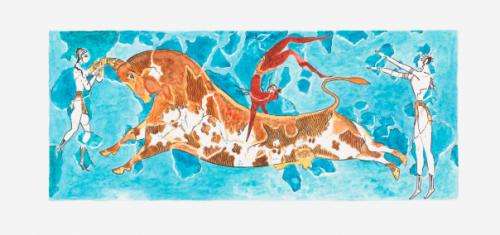One of the buildings in Knossos restored by British archeologist Sir Arthur Evans. Knossos was the major civil center of the Minoans. Credit: Getty Images
(Phys.org) —A new study conducted by a team of American and Greek researchers has found that the people of the ancient Minoan civilization living on the island of Crete most likely came from Europe. In their paper published in the journal Nature Communications, the team says mitochondrial DNA (mtDNA) evidence contradicts the long held notion that the people of the long lost civilization came from Africa.
Evidence of the great Minoan civilization first came to light in 1900, when an excavation by Sir Arthur Evans discovered the Palace of Minos on the island of Crete. Noting similarities between artwork discovered there and in parts of Egypt, Evans suggested it was possible the early inhabitants of the island came from Africa. Since that time, others have concurred, while some suggest the Minoans more likely came from the Middle East, or even from Europe. In this new study, the researchers turned to mtDNA for the true answer.
The team took samples from skeletal remains of over 100 early denizens of the island that had been found in a cave by other researchers. They then compared the mtDNA from those samples with samples taken from people living in the modern world, as well as with some samples from other old world inhabitants.
Illustration of the Bull-leaping Fresco from the Great Palace at Knossos, Crete. Credit: Getty Images
An analysis of the test results indicates that the early inhabitants of Crete were likely farmers who settled on the island long before the appearance of the Minoan society. This suggests that the Minoan civilization most likely came about as a result of the evolution of the early farmers. No evidence of African ancestry was found.
The Minoan civilization existed for approximately 1,200 years, vanishing around 1500 BC. Some suggest their sudden disappearance was due to a volcanic eruption and tsunami, while others say it was more likely the inhabitants of Crete were wiped out be an invading army. In any case, the Minoan civilization is considered to be first advanced civilization of Bronze Age Europe—the people there left behind huge buildings, impressive artwork and mysterious hieroglyphs. It appears likely the early farmers were part of a wave of immigrants coming from the Middle East and Anatolia to Europe looking for land to farm.
As for the similarity between artwork found in Crete and Egypt, the researchers suggest it was most likely the result of trade between the two civilizations.
More information: A European population in Minoan Bronze Age Crete, Nature Communications 4, Article number: 1861 doi:10.1038/ncomms2871
Abstract
The first advanced Bronze Age civilization of Europe was established by the Minoans about 5,000 years before present. Since Sir Arthur Evans exposed the Minoan civic centre of Knossos, archaeologists have speculated on the origin of the founders of the civilization. Evans proposed a North African origin; Cycladic, Balkan, Anatolian and Middle Eastern origins have also been proposed. Here we address the question of the origin of the Minoans by analysing mitochondrial DNA from Minoan osseous remains from a cave ossuary in the Lassithi plateau of Crete dated 4,400–3,700 years before present. Shared haplotypes, principal component and pairwise distance analyses refute the Evans North African hypothesis. Minoans show the strongest relationships with Neolithic and modern European populations and with the modern inhabitants of the Lassithi plateau. Our data are compatible with the hypothesis of an autochthonous development of the Minoan civilization by the descendants of the Neolithic settlers of the island.
Journal information: Nature Communications
© 2013 Phys.org























